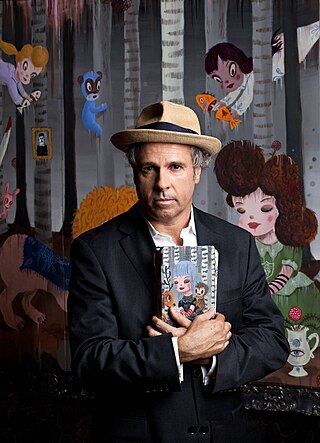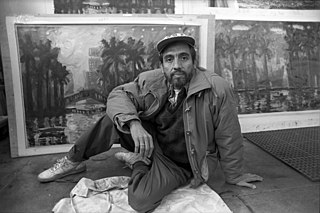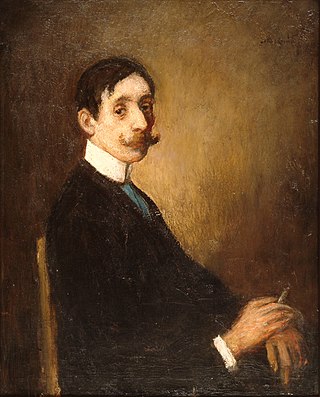
Robert L. Williams, often styled Robt. Williams, is an American painter, cartoonist, and founder of Juxtapoz Art & Culture Magazine. Williams was one of the group of artists who produced Zap Comix, along with other underground cartoonists, such as Robert Crumb, Rick Griffin, S. Clay Wilson, and Gilbert Shelton. His mix of California car culture, cinematic apocalypticism, and film noir helped to create a new genre of psychedelic imagery.

Lowbrow, or lowbrow art, is an underground visual art movement that arose in the Los Angeles, California area in the late 1960s. It is a populist art movement with its cultural roots in underground comix, punk music, tiki culture, graffiti, and hot-rod cultures of the street. It is also often known by the name pop surrealism. Lowbrow art often has a sense of humor – sometimes the humor is gleeful, impish, or a sarcastic comment.

Todd Schorr is an American artist and member of the "Lowbrow", or pop surrealism, art movement. Combining a cartoon influenced visual vocabulary with a highly polished technical ability, based on the exacting painting methods of the Old Masters, Schorr weaves intricate narratives that are often biting yet humorous in their commentary on the human condition.

Hermann Mejía is a Venezuelan–American painter and sculptor known for his work for Mad magazine. He was named by HuffPost as "one of 15 famous Venezuelan artists to know".

Gary Baseman is an American artist, cartoonist, and animator who investigates history, heritage, and the human condition. Through iconography and visual narratives that celebrate “the beauty of the bittersweetness of life,” his work brings together the worlds of popular culture and fine art.

Luke Chueh is a Chinese-American lowbrow, pop surrealist, painter. His works is a juxtaposition of the cute with the macabre, including various self-portraits reimagining himself as a bear character.

Carlos D. Almaraz was a Mexican-American artist and a pioneer of the Chicano art movement. He was one of the founder of the Centro de Arte Público (1977–1979), a Chicano/Chicana arts organization in Highland Park, Los Angeles.
Elsa Flores is a well known Chicana street artist. Her mother's name was Maria Valenzuela and she was originally from a small village called San Javier located in Sinaloa, Mexico. She is one of the best known members of the Chicano street art movement.
Rob Clayton and Christian Clayton are painters based in California.

Robert Dowd was an American artist, who also painted under the name Robert O'Dowd.
Joe Goode, is an American visual artist, known for his pop art paintings. Goode made a name for himself in Los Angeles, California, through his cloud imagery and milk bottle paintings which were associated with the Pop Art movement. The artist is also closely associated with Light and Space, a West Coast art movement of the early 1960s. He resides in Los Angeles, California.
Nancy Calef is a contemporary American figurative painter, illustrator and author. Her work is distinguished by the technique of sculpting off the canvas with clay to produce paintings in three-dimensional high relief. Calef is also a singer/songwriter.

José Chávez Morado was a Mexican artist who was associated with the Mexican muralism movement of the 20th century. His generation followed that of Diego Rivera, José Clemente Orozco and David Alfaro Siqueiros. Although Chávez Morado took classes in California and Mexico, he is considered to be mostly self-taught. He experimented with various materials, and was an early user of Italian mosaic in monumental works. His major works include murals at the Ciudad Universitaria, Secretaría de Comunicaciones y Transportes and Museo Nacional de Antropología in Mexico City as well as frescos at the Alhóndiga de Granaditas, which took twelve years to paint. From the 1940s on, he also worked as a cultural promoter, establishing a number of cultural institutions especially in his home state of Guanajuato including the Museo de Arte Olga Costa - José Chávez Morado, named after himself and his wife, artist Olga Costa.

Celis Pérez was an Argentine artist usually referred to as Pérez Celis. He earned international recognition for his paintings, sculptures, murals and engravings.

Federico Heraclio Cantú Garza was a Mexican painter, engraver and sculptor. While considered to be a member of the Mexican muralism movement, his style was noticeably different, mostly for adhering to older and more academic forms of painting and sculpture. He had his most success exhibiting in the United States and Europe, but he did murals and sculptures in Mexico. His best known work is a sculpture called La maternidad which was adapted as the logo of the Instituto Mexicano de Seguro Social (IMSS).
Duane Flatmo is an American artist best known for his murals, label art and kinetic art sculptures in northern California.

Vladimir Cora is a Mexican painter and sculptor based in the state of Nayarit, whose work has been recognized by various awards and membership in the Salón de la Plástica Mexicana. He discovered art at age fifteen, after deciding that he could not be a musician. He received training in Tijuana and Mexico City, with his first success in the 1980s. His style has been described as neo-figurative, minimalist and coarse, and he creates his works in series usually related to the apostles, flowers, birds and women, especially those related to Nayarit. He has had over 150 individual exhibitions both in Mexico and abroad and continues to work from his home state.
Romulo Royo is a figurative fantasy painter born in 1976 in Zaragoza, Spain.
Jack Earl is an American ceramic artist and former teacher, known for drawing inspiration from his home state of Ohio to create rural pieces “with meticulous craftsmanship and astute details… to where you could smell the air, hear the silence and swat the flies.” Although his works hint at highly personal, intellectual, and narrative themes in an almost unsettling manner, Earl is “a self-described anti-intellectual who shuns the art world." He is known particularly for using his trademark format, the dos-a-dos : “This art form is like a book with two stories… the two seemingly incongruent images prompt the viewer to fill in the conceptual gap through poetic speculation.” His work often involves dogs or the character “Bill”, who is said to be a combination of Earl’s father-in-law, himself, and others. The titles to his pieces are typically lengthy, stream-of-consciousness narratives that suggest the folk or rural lifestyle. These are intended to add another dimension to the artwork. His work has received a notable response over his decades-long career, especially since he is regarded as “a master at reminding us that within the events we take for granted are moments of never-ending mystery and wonder.” Earl continues to live in Lakeview, Ohio with his wife, Fairlie.

F. S. Coburn D.C.L., also known as Frederick Simpson Coburn, was a Canadian painter, illustrator and a photographer of note.













